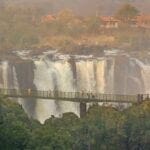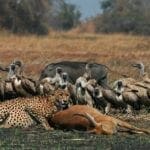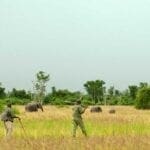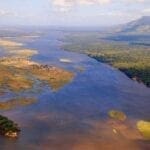Kasanka National Park is on the southwestern edge of the Lake Bangweulu basin, is one of Zambia’s smallest national parks. However, it is so well endowed with rivers, lakes, wetlands, forests, lagoons, meadows and dambos that it supports a uniquely wide range of animals. And abundant birds and fish. What it lacks in size, it certainly makes up for in diversity. It fits in well with a safari in North or South Luangwa National Parks.
Kasanka was once in danger of becoming a defunct national park due to rampant poaching. David Lloyd, a Briton who lived in Zambia, visited the park in 1985 and heard the crack of gunshots. He concluded that if there was still poaching there must still be animals there. And so set out to save the park from total depletion. Teaming up with a local farmer, they sought funding and, along with much of their own resources, applied for official permission to rehabilitate the area. They built tourist camps, roads and bridges and set up the Kasanka Trust to raise funds for this community-based project. Slowly it began to earn a little money from tourists to help cover costs.
Three years later the National Parks and Wildlife Services Department was sufficiently impressed to sign an agreement with the Trust. They allowed full management of the park in conjunction with the department. And to develop it for tourism in partnership with the local community.
Kasanka National Park Wildlife and Activities
Today, Kasanka National Park has some of the rarest birds and animals in the country. Found in the beautiful miombo woodlands, swamp forest, grasslands, floodplains and riverine forest.
Do not expect to see large herds of animals round every corner. But it is one of the most picturesque parks in Zambia with superb bird life.
Recovering from depletion are hippo, sable antelope and Liechtenstein’s Hartebeest. Puku, once reduced to a few hundred, today exceed 1 500. There are fairly big herds of the swamp-dwelling sitatunga, reed buck, water buck, Sharpe’s grysbok and the rare blue monkey. Elephant numbers are also recovering.
The largest resident predator in the park is the leopard. Lions and hyenas no longer reside here. Hyenas do come to visit for part of their annual cycle. Jackals can be seen in the early mornings.
Birding
Kasanka National Park has over 330 bird species recorded. These include rarities such as Pel’s fishing owl, the Pygmy goose, Ross’s Loerie, the osprey and the wattled crane. If you’re lucky you’ll catch a glimpse of a rare shoe bill stork usually around Lake Ndolwa. Chikufwe Plain is an excellent bird watching site too, especially for raptors such as the black-breasted snake eagle.
Bats and the Migration of Kasanka National Park
Kasanka is most famous for an astonishing bat migration. A unique wildlife spectacle every November and December. Millions of straw-colored fruit bats assemble from around Central Africa to roost in an area of ‘Mushitu’ swamp forest. Near the confluence of the Musola and Kasanka Rivers. At around 8-10 million, it is considered the globe’s biggest mammal migration. It is truly an amazing sight!
At twilight, bats fill the sky in all directions. For about twenty minutes they sky is covered as they leave their roost site to feed though the night on abundant seasonal fruit of the “miombo” woodlands. This event is one of Africa’s most amazing and unusual wildlife spectacles. Never forgotten by those lucky enough to witness it.
Visitors can also take guided walks through the forest in the day time. View the bats as they chatter, fly and crawl about their roost. This bat migration has been the subject of intense interest from scientists. They report that it is the largest aggregation of mammals in Africa. And probably the most concentrated in the world. There are also many other interesting species of bat in Kasanka.
Game Watching From Fibwe Hide
The tree hide at ‘Fibwe’ is generally rated as Africa’s best vantage point for observing Sitatunga antelopes. Perched 18 meters / 59ft high in a ‘Mululu’ African Mahogany tree. Giving a panoramic view over the Kapabi swamp. Visitors often see more than 20 sitatunga in a single visit. The record is 94! Occasionally crocodile, bush buck, water buck buffalo and elephant can also be seen from the platform. It is also excellent for spotting many species of birds, including Coucals, Mousebirds, Bohm’s bee-eaters, Ross’s and Schalow’s Louries.
Canoeing on the Luwombwa River
Canoes and motorboats can be hired with guides for some spectacular bird watching, fishing and wildlife viewing. Regular sightings include Monitor Lizards, Crocodiles, Otters, Vervet Monkeys and the rare Blue Monkey. Varied species of raptors, Kingfishers, Bee-eaters, Herons and Sunbirds abound along the river. To only name but a few.
Fishing
The river offers some excellent angling (under special permits). The fierce Tiger fish, several Tilapia species and ‘Barbal’ catfish are likely catches. The lodge staff will willingly cook the catch!
Game Drives
Game drives are always a popular way to see the park and usually reveal a variety of wildlife. Although you miss some of the smaller things when driving, you can get to see a wider variety than you would on foot.
A typical drive in Kasanka will involve stops along the way at interesting spots where you can get out of the car and walk around. Drives are conducted by guides and are arranged according to the requirements of each group rather than at set times and programs.
Drives can also be arranged at night to look for nocturnal animals by spotlight.
Walking Safaris
Getting out on foot is perhaps the best way to appreciate all aspects of a wilderness like Kasanka. It gives you a chance to see the small things as well the more obvious! Follow a Honey Guide to a Bee’s nest or track an Elephant along its spore. Walks can be arranged from 1 hour to 5 days!
Walking trails of several days are a specialty of Kasanka as the terrain and vegetation make for easy walking. The park has many different habitats in its relatively small area so walks are always passing through changing scenery. Walkers are accompanied by an armed scout for safety and also to glean local knowledge. You just carry what they need for the day with other luggage taken ahead separately. A temporary camp is set up ahead so that food and shelter are reached at the end of each day.
One day of the trail is usually spent drifting down the Luwombwa river by canoe. One or 2 nights may be spent at the lodges, but otherwise simple tented camps will be set up each night in remote corners of the park. The scouts always carry a radio for contact with HQ in case of any urgency.
Cycling
Due to the relative scarcity of dangerous animals it is possible for visitors to explore the park by bicycle using the network of roads and paths that cover most of the park. In the near future, some mountain bikes will be available for visitors to hire or for organized bicycle safaris around Kasanka and beyond. However visitors must be escorted by a guide or scout when walking or bicycling.
When to Visit Kasanka National Park
Kasanka is open all year round. Birding is especially good in the wet season from November to March when migrants arrive from the north. Game viewing is best in the dry months from May to October. The bat migration is from late October until around mid-December.
Kasanka National Park Accommodation
There is not much in terms of luxury accommodation. We would recommend Wasa Lodge – a rustic lodge on the eastern edge of Lake Wasa. The lodge is perfectly situated close to Fibwe Hide. From here you have a fantastic view of the Kapabi Swamp. It is very likely that you will spot sitatunga antelopes here. As well as buffalo and in the right season of course the bats.





















